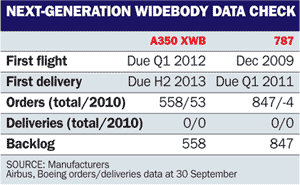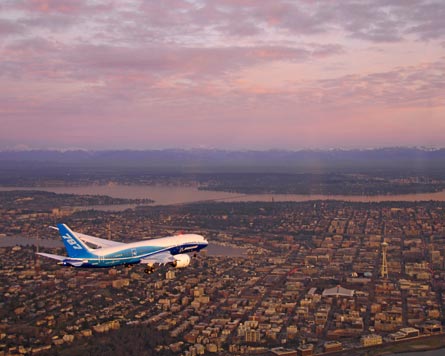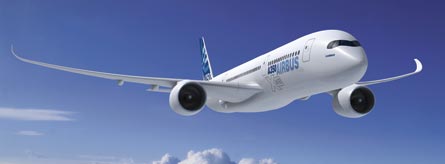Additional reporting by Jon Ostrower
July brought an indisputable high point in the Boeing 787's complex history, when the type was given an air show debut at Farnborough, but a low quickly followed: in August, the airframer confirmed a fresh delay to the 787 programme, citing issues with the Alenia Aeronautica-built horizontal stabiliser and Rolls-Royce Trent 1000 engines.
Meanwhile, Airbus is continuing the stealthy progress of its A350 XWB widebody and is yet to alter its planned delivery schedule, with launch customer Qatar Airways still due to receive its first A350 in mid-2013. However, unforeseen snags have eaten into the buffer that the airframer built into the A350 programme's design and production schedule.
|
|---|
This was the sixth delay to the 787's maiden flight, which took place in December and was performed by R-R Trent 1000-powered aircraft. The first flight of a General Electric GEnx-powered 787 followed in June.
The delay revealed in August pushes first delivery back from the last quarter of this year to the middle of the first quarter of 2011. Under the original schedule, launch customer All Nippon Airways had been due to receive its first 787 as early as May 2008.
"The delay delivery date revision follows an assessment of the availability of an engine needed for the final phases of flight test this fall," said Boeing in August. Early that month, R-R had suffered an uncontained failure of one of the engines originally intended for Airplane Nine, the third production-standard unit and the first that will fly. The failure damaged the engine and the test facility, and postponed by three to four weeks delivery of powerplants to Boeing, with the delay compounded by inspections and rework of the horizontal stabiliser.
|
|---|
In early September, two Trent 1000s were installed on Airplane Nine, which, with Airplane Eight, had been assigned to the ETOPS (extended twin-engine operations) and functionality and reliability trials. Airplane Seven, the first production 787, is to be handed over to All Nippon Airways in mid-February.
As part of efforts to bring its 787 supply chain under control in 2009, Boeing moved to acquire control of Vought Aircraft Industries' North Charleston, South Carolina facility, which produces the type's aft fuselage, and in October that year it decided to locate its second 787 final assembly line there.
This is the first new-aircraft final assembly line Boeing has located in the USA since the Everett factory opened for 747 production in 1968. It is to start final assembly of its first 787-8 in July. After delivering its first aircraft in the second quarter of 2012, it is due to ramp up to a rate of three a month. As a result of Everett's steeper ramp-up - which provides for a temporary surge line - the two factories' output is to reach 10 aircraft a month by the end of 2013.
In April Boeing's drive to iron out kinks in its 787 supply chain led it to halt deliveries of 787 structural assemblies for 24 manufacturing days, to avoid a repeat of the 1997 manufacturing pile-up of incomplete Next Generation 737s. Production was at that point running at two aircraft a month before rising to 2.5 a month from August.
In the lead-up to the 24-manufacturing day hold, Boeing had discovered a structural issue with skin attachments in the 787's rear fuselage. Shear ties, which attach the fuselage frames to the skin, were in need of replacement or rework because the initial design failed to take into account thermal fatigue loading of the aluminium parts, with the result that repeated cooling and warming of unpressurised tail fuselage sections would cause the ties to pull away from the fuselage skin. In response, Boeing elected to use thicker ties and radius fillers on future 787s, a fix requiring 400h to install at suppliers and potentially double that for aircraft already assembled.
The hold concluded with Boeing planning to quicken the pace of deliveries by reducing the time between rate breaks. However, June had not elapsed when the issue of 787 workmanship again reared its head, as Boeing disclosed that it had to undertake inspections on the entire fleet of the horizontal stabilisers built by Alenia Aeronautica in Foggia, Italy, following discovery of over-torqued fasteners and improperly installed shims in the rear spar.
Like the 787, Airbus's A350 makes heavy use of composite material, and in September the European airframer reached a programme milestone when it started test-flying a carbonfibre-reinforced plastic fuselage panel intended to become a standard structural component of its newest type. A regular aluminium fuselage section on one of Airbus's A340 test aircraft was replaced with the panel, which had been manufactured at its facility in Nantes. Airbus then embarked on a three-week flight-test programme to assess the acoustic characteristics of the carbonfibre-reinforced plastic under pressurised conditions.
Also in September, the airframer sealed a pact with CCAC under which the Chinese company gains responsibility for manufacture of the A350's spoilers and droop panels. This completed the allocation of a 5% programme share to China. CCAC's A350 components will make extensive use of carbonfibre reinforced plastic. Joint venture Airbus (Beijing) Engineering Centre will work on related design activity, while Austrian firm FCC is responsible for definition of the industrial process.
In a busy month for the programme, Airbus also opened a €39 million ($54 million) A350 XWB landing gear systems test facility in Filton, UK.
Final assembly of the first A350 is due to begin in Toulouse in September 2011, followed by the start of fatigue testing at the beginning of 2012, first flight in mid-2012, and first delivery - to Qatar Airways - a year later. The A350-900 is the type's baseline variant, to be followed into service by the -800 shrink in 2014 and the -1000 stretch in 2015.
In 2009 the -800 was redefined to be a simple "cut and shut" of the A350-900 - rather than having an optimised structure and landing gear - with potentially 215nm (400km) more range, but also a fuel-burn penalty that Airbus says amounts to "a few percent".
Thanks to buffers it built into its A350 plans, Airbus was able, in April, to tell customers that delivery timings would not change despite the design and production schedule for the -900 having slipped by three months.
That delay was due to factors that arose during the final stages of detail design for certain parts of the airframe's structure, requiring more time to be allocated to validation of the finite element model. This pushed back the machining of certain parts and, consequently, the start of assembly and first flight. The first material cut for the horizontal cruciform should have occurred in November 2009, but slipped to March this year. This in turn delayed the assembly of the centre wingbox.
|
|---|
The four areas for which Airbus required fixes were the airframe sizing, the wing-root joint, the fuselage's electric structural network and the fuselage damage tolerance. While the A380's construction principle was adopted in designing the root joint, there were differences as, unlike the A380, the A350 has a fully composite outer wingbox.
In testing the damage tolerance of the A350 fuselage - which incorporates carbonfibre skin panels attached to carbonfibre frames and metallic cross-beams - it was necessary to consider that while the external appearance can be unblemished, there could be internal delamination. This consideration added to the rigour required during tests. Airbus also programmed additional testing of the electric structural network, the design of which must be optimised to avoid a weight penalty offsetting any advantage that the lighter carbonfibre fuselage offers.

Slippage in the structural design and assembly schedule has led to the flight-test programme being cut back to 12 months from an originally planned 15. Five aircraft are to be allocated to the 2,600h flight-test programme.
In parallel with the 787 programme's technical hitches, the type's orderbook continued to shrink this year. Cancellations outweighed orders by 59 units last year, and at 14 September there had been four fewer orders (28) than cancellations (32) on the type in 2010, leaving total orders standing at 847 aircraft, of which 642 were 787-8s and 205 787-9s.
A contributor to the falling figure is the disappearance from the orderbook of Dubai Aerospace Enterprise, a customer for 15 787-8s ordered in 2007. Air Berlin has cancelled 10 787-8 orders, and AWAS's six 787 orders have vanished, as has an order for a VIP 787.
The loss of these commitments was to some extent offset by new orders from United Airlines (for 25 787s) and Royal Jordanian (three). Air China, meanwhile, converted an order for 15 787-8s to 787-9s. The fate of Boeing's other 787 variant, the short- to medium-haul 787-3, has been uncertain since the order backlog fell to zero in January, when ANA switched 28 orders to the 787-8 model, prompting the airframer to initiate a market study on the viability of the short- to medium-haul 787 variant.
Like the Boeing 787, the A350 has this year lost orders placed by Dubai Aerospace Enterprise, although in this case the cancellation was only partial, affecting seven of 30 aircraft ordered. However, with Cathay Pacific making a firm commitment to take 30 A350-900s, the type's orderbook has grown this year and at the end of September comprised 558 aircraft: 158 A350-800s, 325 A350-900s and 75 A350-1000s. Cathay's was the first new A350 order since Ethiopian Airlines confirmed one for 12 -900s at the 2009 Dubai air show.

Source: Flight International






















